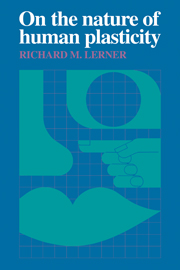Book contents
- Frontmatter
- Contents
- Foreword by Paul Baltes
- Preface
- 1 Perspectives on plasticity
- 2 The life-span view of human development: philosophical, historical, and substantive bases
- 3 Gene marking, recombinant DNA technology, and gene transfer: toward true gene therapy
- 4 Neuroanatomical bases of human plasticity
- 5 Human neurochemistry and the role of neurotransmitters
- 6 Evolutionary biology and hominid evolution
- 7 Comparative-developmental psychological bases of plasticity
- 8 Individual and group interdependencies
- 9 Toward future multidisciplinary efforts
- 10 Conclusions: On the limits of plasticity and the plasticity of limits
- References
- Author index
- Subject index
3 - Gene marking, recombinant DNA technology, and gene transfer: toward true gene therapy
Published online by Cambridge University Press: 22 March 2010
- Frontmatter
- Contents
- Foreword by Paul Baltes
- Preface
- 1 Perspectives on plasticity
- 2 The life-span view of human development: philosophical, historical, and substantive bases
- 3 Gene marking, recombinant DNA technology, and gene transfer: toward true gene therapy
- 4 Neuroanatomical bases of human plasticity
- 5 Human neurochemistry and the role of neurotransmitters
- 6 Evolutionary biology and hominid evolution
- 7 Comparative-developmental psychological bases of plasticity
- 8 Individual and group interdependencies
- 9 Toward future multidisciplinary efforts
- 10 Conclusions: On the limits of plasticity and the plasticity of limits
- References
- Author index
- Subject index
Summary
Are human genetic processes sufficiently plastic to permit the development of intraindividual flexibility? Before addressing this question it is useful to consider how thoroughly human genetic endowment ensures systematic interindividual differences. Our genetic endowment provides a basis of the uniqueness of each human life and provides substance to the claim that all humans have a unique heredity–environment interactive history (Hirsch, 1970; Lerner, 1976, 1978, 1979; McClearn, 1981). Estimates of the number of gene pairs in humans typically range between 10,000 and 100,000 (Bodmer & Cavalli-Sfarza, 1976; Stern, 1973), and if one considers how much genotypic variability can be produced by the reshuffling process of meiosis occurring with 100,000 gene pairs, then the potential for variability is so enormous that “it is next to impossible that there have ever been two individuals with the same combination of genes” (McClearn, 1981, p. 19).
Indeed, Hirsch (1970) conservatively estimates that there are over 7 × 1017 (70 trillion) potential human genotypes. Bodmer and Cavalli-Sforza (1976) estimate that each human has the capacity to generate any one of 103000 different eggs or sperm; by comparison, their estimate of the number of sperm of all men who have ever lived is only 1024. Thus, considering
103000 possible eggs being generated by an individual woman and 103000 possible sperm being generated by an individual man, the likelihood of anyone ever – in the past, present, or future – having the same genotype as anyone else (excepting multiple identical births, of course) becomes dismissably small
(McClearn, 1981, p. 19).- Type
- Chapter
- Information
- On the Nature of Human Plasticity , pp. 33 - 43Publisher: Cambridge University PressPrint publication year: 1984



